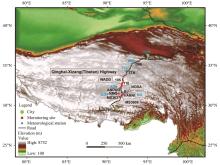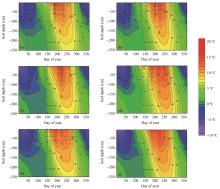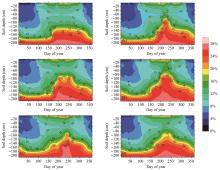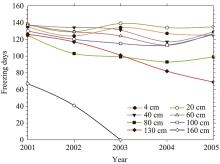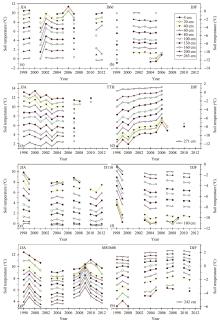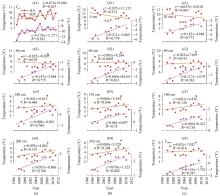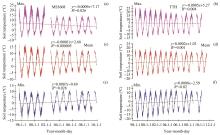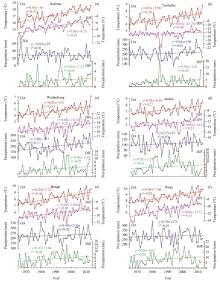Sciences in Cold and Arid Regions ›› 2021, Vol. 13 ›› Issue (4): 299–313.doi: 10.3724/SP.J.1226.2021.20024.
• • 上一篇
Ground temperature variation and its response to climate change on the northern Tibetan Plateau
GuoNing Wan,MeiXue Yang( ),XueJia Wang
),XueJia Wang
- Yulong Snow Mountain National Field Observation and Research Station for Cryosphere and Sustainable Development, State Key Laboratory of Cryospheric Science, Northwest Institute of Eco-Environment and Resources, Chinese Academy of Sciences, Lanzhou, Gansu 730000, China
|
Chen R, Yang MX, Wang XJ, et al., 2019. Review on simulation of land-surface processes on the Tibetan Plateau. Sciences in Cold and Arid Regions, 11(2): 93-115. DOI: 10. 3724/SP.J.1226.2019.00093.
doi: 10. 3724/SP.J.1226.2019.00093 |
|
| Cheng GD, Wang SL, 1982. On the zonation of high-altitude permafrost in China. Journal of Glaciology and Geocryology, 4(2): 1-17. (in Chinese) | |
|
Cheng GD, Wu TH, 2007. Responses of permafrost to climate change and their environmental significant, Qinghai-Tibet Plateau. Journal of Geophysical Research, 112: F02S03. DOI: 10.1029/2006JF000631.
doi: 10.1029/2006JF000631 |
|
|
Chow KC, Chan JC, Shi XL, et al., 2008. Time-lagged effects of spring Tibetan Plateau soil moisture on the monsoon over China in early summer. International Journal of Climatology, 28: 55-67. DOI: 10.1002/joc.1511.
doi: 10.1002/joc.1511 |
|
|
Ding YJ, Ye BS, Liu SY, et al., 2000. Monitoring of frozen soil hydrology in macro-scale in Qinghai-Xizang plateau. Chinese Science Bulletin, 45: 1143-1149. DOI: CNKI:SUN:JXTW.0.2000-12-016.
doi: CNKI:SUN:JXTW.0.2000-12-016 |
|
|
Ge SM, McKenzie J, Voss C, et al., 2011. Exchange of groundwater and surface-water mediated by permafrost response to seasonal and long term air temperature variation. Geophysical Research Letters, 38: L14402. DOI: 10.1029/2011GL047911.
doi: 10.1029/2011GL047911 |
|
|
Guglielmin M, Balks MR, Adlam LS, et al., 2011. Permafrost Thermal Regime from Two 30-m Deep Boreholes in Southern Victoria Land, Antarctica. Permafrost and Periglacial Processes, 22: 129-139. DOI: 10.1002/ppp.715.
doi: 10.1002/ppp.715 |
|
|
Guo DL, Yang MX, Wang HJ, 2011a. Characteristics of land surface heat and water exchange under different soil freeze/thaw conditions over the central Tibetan Plateau. Hydrological Processes, 25(16): 2531-2541. DOI: 10.1002/hyp.8025.
doi: 10.1002/hyp.8025 |
|
|
Guo DL, Yang MX, Wang HJ, 2011b. Sensible and latent heat flux response to diurnal variation in soil surface temperature and moisture under different freeze/thaw soil conditions in the seasonal frozen soil region of the central Tibetan Plateau. Environmental Earth Sciences, 63: 97-107. DOI: 10.1007/s12665-010-0672-6.
doi: 10.1007/s12665-010-0672-6 |
|
|
Guo DL, Wang HI, Li D, 2012. A projection of permafrost degradation on the Tibetan Plateau during the 21st century. Journal of Geophysical Research, 117: D05106. DOI: 10.1029/2011JD016545.
doi: 10.1029/2011JD016545 |
|
|
Guo DL, Wang AH, Li D, et al., 2018. Simulation of changes in the near-surface soil freeze/thaw cycle using CLM4.5 with four atmospheric forcing data sets. Journal of Geophysical Research, 123: 2509-2523. DOI: 10.1002/2017JD028097.
doi: 10.1002/2017JD028097 |
|
|
Hao X, 2008. A green fervor sweeps the Qinghai-Tibetan Plateau. Science, 321(5889): 633-635. DOI: 10.1126/science. 321.5889.633.
doi: 10.1126/science. 321.5889.633 |
|
|
Harris C, Kern LM, Christiansen HH, et al., 2011. The role of interannual climate variability in controlling solifluction processes, Endalen, Svalbard. Permafrost and Periglacial Processes, 22: 239-253. DOI: 10.1002/ppp.727.
doi: 10.1002/ppp.727 |
|
|
Harris C, Mühll DV, Isaksen K, et al., 2003. Warming permafrost in European mountains. Global and Planetary Change, 39(3-4): 215-225. DOI: 10.1016/j.gloplacha.2003.04.001.
doi: 10.1016/j.gloplacha.2003.04.001 |
|
|
Immerzeel WW, van Beek LH, Bierkens MP, 2010. Climate change will affect the Asian Water Towers. Science, 328: 1382-1385. DOI:10.1126/science.1183188.
doi: 10.1126/science.1183188 |
|
|
Kang SC, Xu YW, You QL, et al., 2010. Review of climate and cryospheric change in the Tibetan Plateau. Environmental Research Letters, 5: 015101. DOI: 10.1088/1748-9326/5/1/015101.
doi: 10.1088/1748-9326/5/1/015101 |
|
|
Lawrence DM, Slater AG, 2005. A projection of severe near-surface permafrost degradation during the 21st century. Geophysical Research Letters,32(L24401): 1-5. DOI: 10. 1029/2005GL025080.
doi: 10. 1029/2005GL025080 |
|
|
Li X, Cheng GD, Jin HJ, 2008. Cryospheric change in China. Global and Planetary Change, 62(3-4): 210-218. DOI: 10.1016/j.gloplacha.2008.02.001.
doi: 10.1016/j.gloplacha.2008.02.001 |
|
|
Luo DL, Jin HJ, Wu QB, et al., 2018. Thermal regime of warm-dry permafrost in relation to ground surface temperature in the Source Areas of the Yangtze and Yellow rivers on the Qinghai-Tibet Plateau, SW China. Science of The Total Environment, 618: 1033-1045. DOI: 10.1016/j.scitotenv.2017.09.083.
doi: 10.1016/j.scitotenv.2017.09.083 |
|
|
Mu CC, Zhang TJ, Zhang XK, et al., 2016. Carbon loss and chemical changes from permafrost collapse in the northern Tibetan Plateau. Journal of Geophysical Research, 121: 1781-1791. DOI: 10.1002/2015JG003235.
doi: 10.1002/2015JG003235 |
|
|
Mu CC, Zhang TJ, Zhao Q, et al., 2017. Permafrost affects carbon exchange and its response to experimental warming on the northern Qinghai-Tibetan Plateau. Agricultural and Forest Meteorology, 247: 252-259. DOI: 10.1016/j.agrformet.2017.08.009.
doi: 10.1016/j.agrformet.2017.08.009 |
|
|
Nan ZT, Li SX, Cheng GD, 2005. Prediction of permafrost distribution on the Qinghai-Tibet Plateau in the next 50 and 100 years. Science China Earth Sciences, 48: 797-804. DOI: 10. 1360/03yd0258.
doi: 10. 1360/03yd0258 |
|
|
Nelson FE, 2003. (Un)frozen in Time. Science, 299(5614): 1673-1675. DOI: 10.1126/science.1081111.
doi: 10.1126/science.1081111 |
|
|
Oelke C, Zhang TJ, 2007. Modeling the active-layer depth over the Tibetan plateau. Arctic Antarctic and Alpine Research, 39(4): 714-722. DOI: 10.1657/1523-0430(06-200).
doi: 10.1657/1523-0430(06-200 |
|
|
Osterkamp TE, 2007. Characteristics of the recent warming of permafrost in Alaska. Journal of Geophysical Research, 112: F02S02. DOI: 10.1029/2006JF000578.
doi: 10.1029/2006JF000578 |
|
|
Peng SS, Piao SL, Ciais P, et al., 2013. Asymmetric effects of daytime and night-time warming on Northern Hemisphere vegetation. Nature, 501: 88-92. DOI: 10.1038/nature12434.
doi: 10.1038/nature12434 |
|
|
Qin DH, Ding YJ, Xiao CD, et al., 2018. Cryospheric Science: research framework and disciplinary system. National Science Review, 5(2): 255-268. DOI: 10.1093/nsr/nwx108.
doi: 10.1093/nsr/nwx108 |
|
|
Richard AK, 2007. Global Warming Is Changing the World. Science, 316(5822):188-190. DOI: 10.1126/science.316. 5822.188.
doi: 10.1126/science.316. 5822.188 |
|
|
Richard AK, 2010. 'Arctic armageddon' needs more science, less hype. Science, 329(5992): 620-621. DOI: 10.1126/science.329.5992.620.
doi: 10.1126/science.329.5992.620 |
|
|
Romanovsky VE, Smith SL, Christiansen HH, 2010. Permafrost Thermal State in the Polar Northern Hemisphere during the International Polar Year 2007-2009: a Synthesis. Permafrost and Periglacial Processes, 21(2): 106-116. DOI: 10.1002/ppp.689.
doi: 10.1002/ppp.689 |
|
|
Smith NV, Saatchi SS, Randerson JT, 2004. Trends in high northern latitude soil freeze and thaw cycles from 1988 to 2002. Journal of Geophysical Research, 109: D12101. DOI: 10.1029/2003JD004472.
doi: 10.1029/2003JD004472 |
|
|
Smith SL, Romanovsky VE, Lewkowicz AG, et al., 2010. Thermal State of Permafrost in North America: A Contribution to the International Polar Year. Permafrost and Periglacial Processes, 21(2): 117-135. DOI: 10.1002/ppp.690.
doi: 10.1002/ppp.690 |
|
|
Subke JA, Reichstein M, Tenhunen JD, 2003. Explaining temporal variation in soil CO2 efflux in a mature spruce forest in Southern Germany. Soil Biology and Biochemistry, 35(11): 1467-1483. DOI: 10.1016/S0038-0717(03)00241-4.
doi: 10.1016/S0038-0717(03)00241-4 |
|
|
Tong CJ, Wu QB, 1996. The effect of climate warming on the Qinghai-Tibetan Highway. Cold Regions Science and Technology, 24(1): 101-106. DOI: 10.1016/0165-232X(95)00012-Z.
doi: 10.1016/0165-232X(95)00012-Z |
|
|
Wang GX, Liu GS, li CJ, 2012. Effects of changes in alpine grassland vegetation cover on hillslope hydrological processes in a permafrost watershed. Journal of Hydrology, 444-445: 22-33. DOI: 10.1016/j.jhydrol.2012.03.033.
doi: 10.1016/j.jhydrol.2012.03.033 |
|
|
Wang XJ, Yang MX, Pang GJ, 2015a. Influences of two land-surface schemes on RegCM4 precipitation simulations over the Tibetan Plateau. Advances in Meteorology, 106891: 1-12. DOI:10.1155/2015/106891.
doi: 10.1155/2015/106891 |
|
|
Wang XJ, Yang MX, Pang GJ, et al., 2015b. Simulation and improvement of land surface processes in Nameqie, Central Tibetan Plateau, using the Community Land Model (CLM3.5). Environmental Earth Sciences, 73: 7343-7357. DOI: 10.1007/s12665-014-3911-4.
doi: 10.1007/s12665-014-3911-4 |
|
|
Wang XJ, Pang GJ, Yang MX, et al., 2016. Effects of modified soil water-heat physics on RegCM4 simulations of climate over the Tibetan Plateau. Journal of Geophysical Research, 121(12): 6692-6712. DOI: 10.1002/2015JD024407.
doi: 10.1002/2015JD024407 |
|
|
Wu QB, Niu FJ, 2013. Permafrost changes and engineering stability in Qinghai-Xizang Plateau. Chinese Science Bulletin, 58(10): 1079-1094. DOI: 10.1007/s11434-012-5587-z.
doi: 10.1007/s11434-012-5587-z |
|
|
Wu QB, Zhang TJ, 2008. Recent permafrost warming on the Qinghai-Tibetan Plateau. Journal of Geophysical Research, 113: D13108. DOI: 10.1029/2007jd009539.
doi: 10.1029/2007jd009539 |
|
|
Wu QB, Zhang TJ, 2010. Changes in active layer thickness over the Qinghai-Tibetan Plateau from 1995 to 2007. Journal of Geophysical Research, 115: D09107. DOI: 10.1029/2009JD012974.
doi: 10.1029/2009JD012974 |
|
|
Wu SH, Yin YH, Zheng D, et al., 2006. Moisture conditions and climate trends in China during the period 1971-2000. International Journal of Climatology, 26: 193-206. DOI: 10.1002/joc.1245.
doi: 10.1002/joc.1245 |
|
|
Wu WR, Dickinson RE, Wang H, et al., 2007. Covariabilities of spring soil moisture and summertime United States precipitation in a climate simulation. International Journal of Climatology, 27: 429-438. DOI: 10.1002/joc.1419.
doi: 10.1002/joc.1419 |
|
|
Wu X, Bruggemann N, Gasche R, et al., 2010. Environmental controls over soil-atmosphere exchange of N2O, NO and CO2 in a temperate Norway spruce forest. Global Biogeochemical Cycles, 24(GB2012): 1-16. DOI:10.1029/ 2009GB003616.
doi: 10.1029/ 2009GB003616 |
|
|
Xue X, Guo J, Han BS, et al., 2009. The effect of climate warming and permafrost thaw on desertification in the Qinghai-Tibetan Plateau. Geomorphology, 108(3-4): 182-190. DOI: 10.1016/j.geomorph.2009.01.004.
doi: 10.1016/j.geomorph.2009.01.004 |
|
|
Yang MX, Yao TD, Gou XH, et al., 2003. The soil moisture distribution, thawing-freezing processes and their effects on the seasonal transition on the Qinghai-Xizang (Tibetan) Plateau. Journal of Asian Earth Sciences, 21(5): 457-465. DOI: 10.1016/S1367-9120(02)00069-X.
doi: 10.1016/S1367-9120(02)00069-X |
|
| Yang MX, Yao TD, Gou XH, 2000. The soil thawing-freezing processes and water-energy distribution along the Qinghai-Xizang (Tibet) Plateau. Progress in Natural Science, 10(5): 443-450. (in Chinese) | |
|
Yang MX, Nelson FE, Shiklomanov NI, et al., 2010. Permafrost degradation and its environmental effects on the Tibetan Plateau: A review of recent research. Earth-Science Reviews, 103(1-2): 31-44. DOI: 10.1016/j.earscirev.2010. 07.002.
doi: 10.1016/j.earscirev.2010. 07.002 |
|
|
Yang MX, Yao TD, Gou XH, 2007. Diurnal freeze/thaw cycles of the ground surface on the Tibetan Plateau. Chinese Science Bulletin, 52(1): 136-139. DOI : 10.1007/s11434-007-0004-8.
doi: 10.1007/s11434-007-0004-8 |
|
|
Yang MX, Yao TD, Nelson FE, et al., 2008. Snow cover and depth of freeze-thaw on the Tibetan Plateau: a case study from 1997 to 1998. Physical Geography, 29(3): 208-221. DOI: 10.2747/0272-3646.29.3.208.
doi: 10.2747/0272-3646.29.3.208 |
|
|
Yang MX, Wang SL, Yao TD, et al., 2004. Desertification and its relationship with permafrost degradation in Qinghai-Xizang (Tibet) Plateau. Cold Regions Science and Technology, 39(1): 47-53. DOI: 10.1016/j.coldregions.2004.01.002.
doi: 10.1016/j.coldregions.2004.01.002 |
|
|
Yang MX, Wang XJ, Pang GJ, et al., 2019. The Tibetan Plateau cryosphere: Observations and model simulations for current status and recent changes. Earth-Science Reviews, 190: 353-369. DOI: 10.1016/j.earscirev.2018.12.018.
doi: 10.1016/j.earscirev.2018.12.018 |
|
|
Yasunari T, Kitoh A, Tokioka T, 1991. Local and remote responses to excessive snow mass over Eurasia appearing in the northern spring and summer climate-A study with the MRI-GCM. Journal of the Meteorological Society of Japan, 69(4): 473-487. DOI: 10.2151/jmsj1965.69.4_473.
doi: 10.2151/jmsj1965.69.4_473 |
|
|
Zhang TJ, Barry RG, Knowles K, et al., 2008. Statistics and characteristics of permafrost and ground ice distribution in the Northern Hemisphere. Polar Geography, 31(1): 47-68. DOI: 10.1080/10889370802175895.
doi: 10.1080/10889370802175895 |
|
| Zhang TJ, Barry RG, Knowles K, et al., 2003. Distribution of seasonally and perennially frozen ground in the Northern Hemisphere. In Proceedings of the 8th International Conference on Permafrost, 2: 1289-1294. Zurich: A. A. Balkema Publishers. | |
|
Zhang TJ, 2005. Influence of the seasonal snow cover on the ground thermal regime: an overview. Reviews of Geophysics, 43(RG4002): 1-23. DOI: 10.1029/2004RG000157.
doi: 10.1029/2004RG000157 |
|
|
Zhang TJ, 2007. Perspectives on environmental study of response to climatic and land cover/land use change over the Qinghai-Tibetan plateau: an introduction. Arctic Antarctic and Alpine Research, 39(4): 631-641. DOI: 10.1657/1523-0430(07-513).
doi: 10.1657/1523-0430(07-513 |
|
|
Zhang YL, Chang XL, Liang J, et al., 2016. Influence of frozen ground on hydrological processes in alpine regions: a case study in an upper reach of the Heihe River. Journal of Glaciology and Geocryology, 38(5): 1362-1372. DOI: 10.7522/j.issn.1000-0240.2016.0160. (in Chinese)
doi: 10.7522/j.issn.1000-0240.2016.0160. |
|
|
Zhao L, Cheng GD, Li SX, et al., 2000. Thawing and freezing processes of active layer in Wudaoliang region of Tibetan Plateau. Chinese Science Bulletin, 45(23): 2181-2186. DOI: 10. 1007/BF02886326.
doi: 10. 1007/BF02886326 |
|
|
Zhao L, Ping CL, Yang DQ, et al., 2004. Changes of climate and seasonally frozen ground over the past 30 years in Qinghai-Xizang (Tibetan) Plateau, China. Global and Planetary Change, 43(1-2): 19-31. DOI: 10.1016/j.gloplacha.2004. 02.003.
doi: 10.1016/j.gloplacha.2004. 02.003 |
|
|
Zhao L, Wu QB, Marchenko SS, et al., 2010. Thermal state of permafrost and active layer in central Asia during the International Polar Year. Permafrost and Periglacial Processes, 21(2): 198-207. DOI: 10.1002/ppp.688.
doi: 10.1002/ppp.688 |
|
|
Zimov SA, Schuur EAG, Stuart CF, 2006. Permafrost and the Global Carbon Budget. Science, 312(5780): 1611-1613. DOI: 10.1126/science.1128908.
doi: 10.1126/science.1128908 |
|
|
Zou DF, Zhao L, Sheng Y, et al., 2017. A new map of permafrost distribution on the Tibetan Plateau. The Cryosphere, 11: 2527-2542. DOI: 10.5194/tc-2016-187.
doi: 10.5194/tc-2016-187 |
| No related articles found! |
|
||

